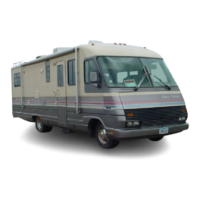Generator Fuel Supply
Fuel for the gasoline or diesel generator
is
taken
from the main fuel tank through a special feeder
tube which is higher in the tank than the feeder
tube to the motor home
engine,. This arrange-
ment prevents the generator from running the
motor home fuel tank dry.
LP
Generator
(If
Equipped)
Fuel is provided from a dedicated LP gas tank.
Generator Operations
To
start
the
generator:
1.
Press generator remote switch until generator
is
running.
2. To stop the unit, press switch and release.
If
the generator is slow to start, DO NOT hold
the switch in the START position for more than
10 seconds. Release the switch, wait
15
sec-
onds, then try to start again. This will help avoid
overheating and damage to the generator start-
ing system.
v"1
NOTE I
Refer
to
the
generator operating instructions provided
in
your Owner's Information Package for informa-
tion before starting the generator.
Do
not start the
generator unit with
a heavy power
load.
Always wait
at
least three minutes after starting generator before
turning
on
(or plugging in) heavy electrical loads,
such
as
the roof air conditioner.
Generator Operating Safety
Precautions
Read and understand the generator operating,
maintenance and safety instruction furnished in
your
Owner's Inforlllation Package.
• Do not smoke or use an open flame near
the generator unit or fuel tank.
• Do not use generator ventilation air for
heating any space.
Electrical
Systems
• Check engine fuel lines . Fuel. leakage in or
around the compartment is an extreme fire
hazard. Do not use the generator until fuel
leaks are repaired.
• Check to be sure the generator exhaust pipe
is located to discharge exhaust gases away
from the
RY.
• During stops while traveling, inspect the
exhaust systems for road damage. Do not
operate an engine with a damaged exhaust
system.
• Be aware
of
exhaust gas (carbon monox-
ide) poisoning symptoms. Refer to the sec-
tion on
Carbon Monoxide Safety Pre-
cautions in the On The Road chapter.
• Check the generator exhaust system after
every usage and whenever the system may
have been damaged, and repair any leaks or
obstructions before further operation.
• Check the exhaust systems(s) during routine
maintenance, and repair any leaks, damage,
or obstructions before
fUither
operations.
• Disconnect the battery(ies) before performing
any maintenance on the generator. Allow the
generator to cool before pelfonning any
maintenance.
• Do not use the generator as an emergency
power .source to a general residential or
industrial utility line. This is illegal and
may cause shock or electrocution to power
line utility personnel attempting to repair
power lines.
A.
WARNING
Do
not place
flamm~ble
material or store any other
materials
in
the generator compartment.
A.
WARNING
Do
not operate the generator when parked
in
or near
high grass or brush. Exhaust component heat may
cause a fire.
08-5
1-.
---

